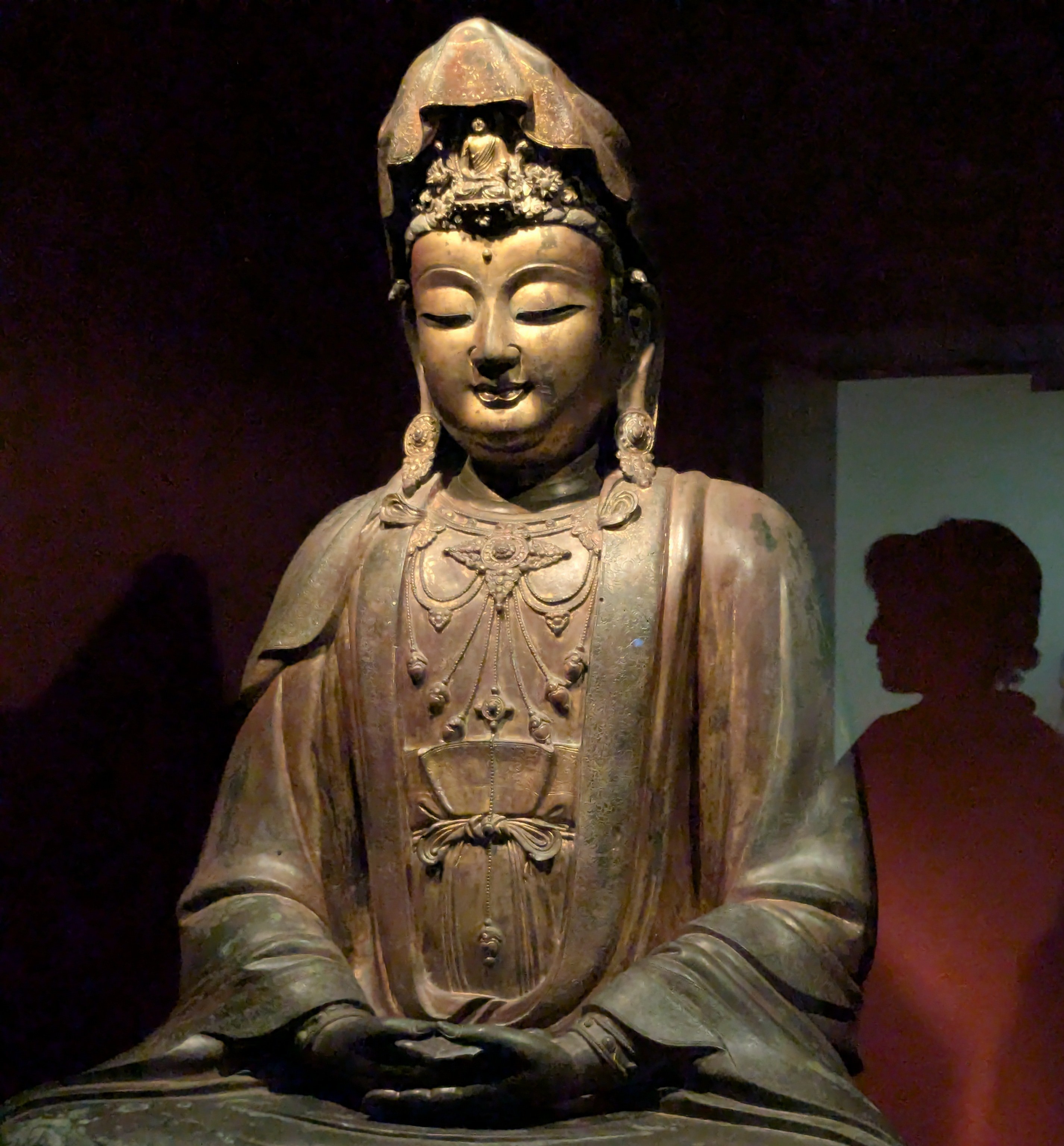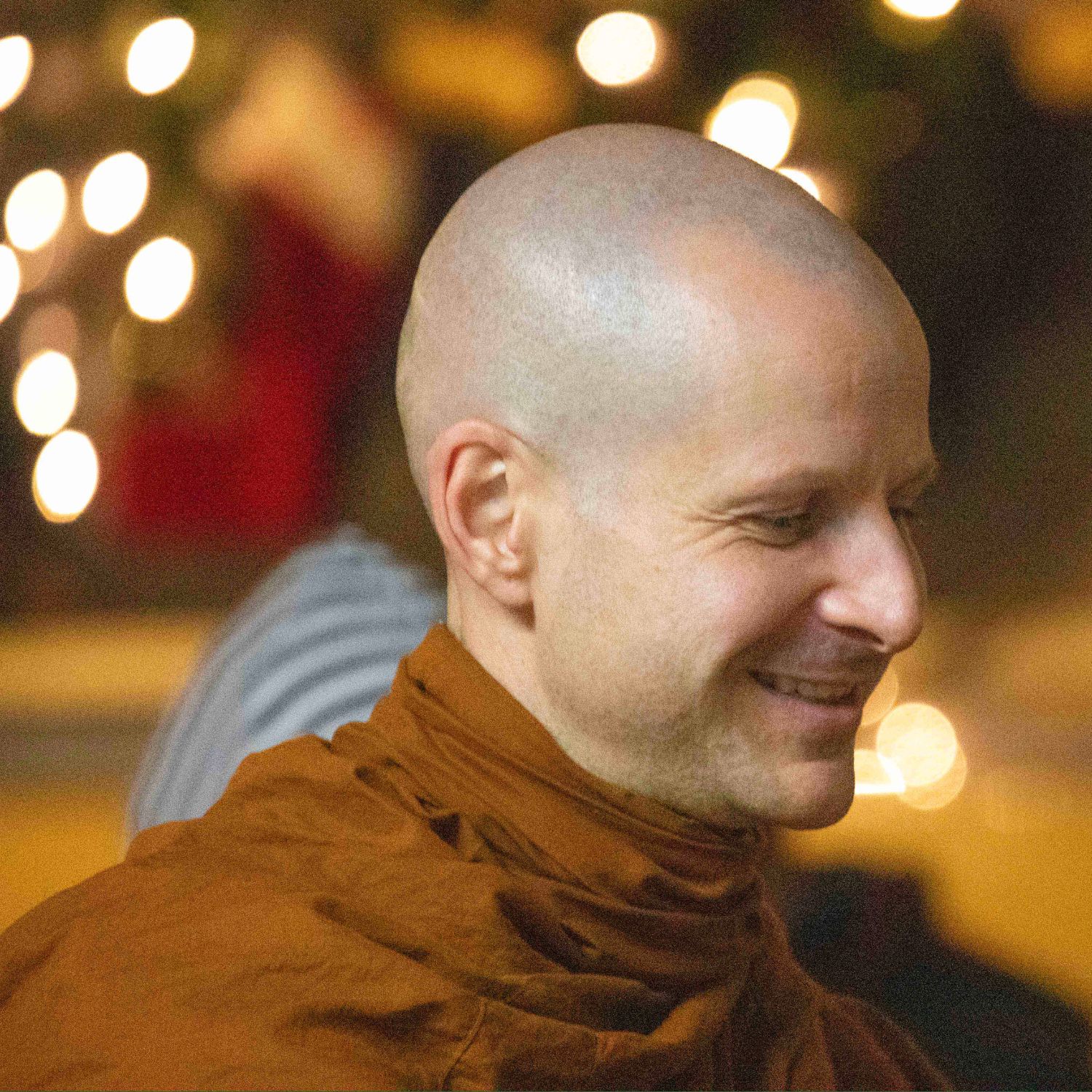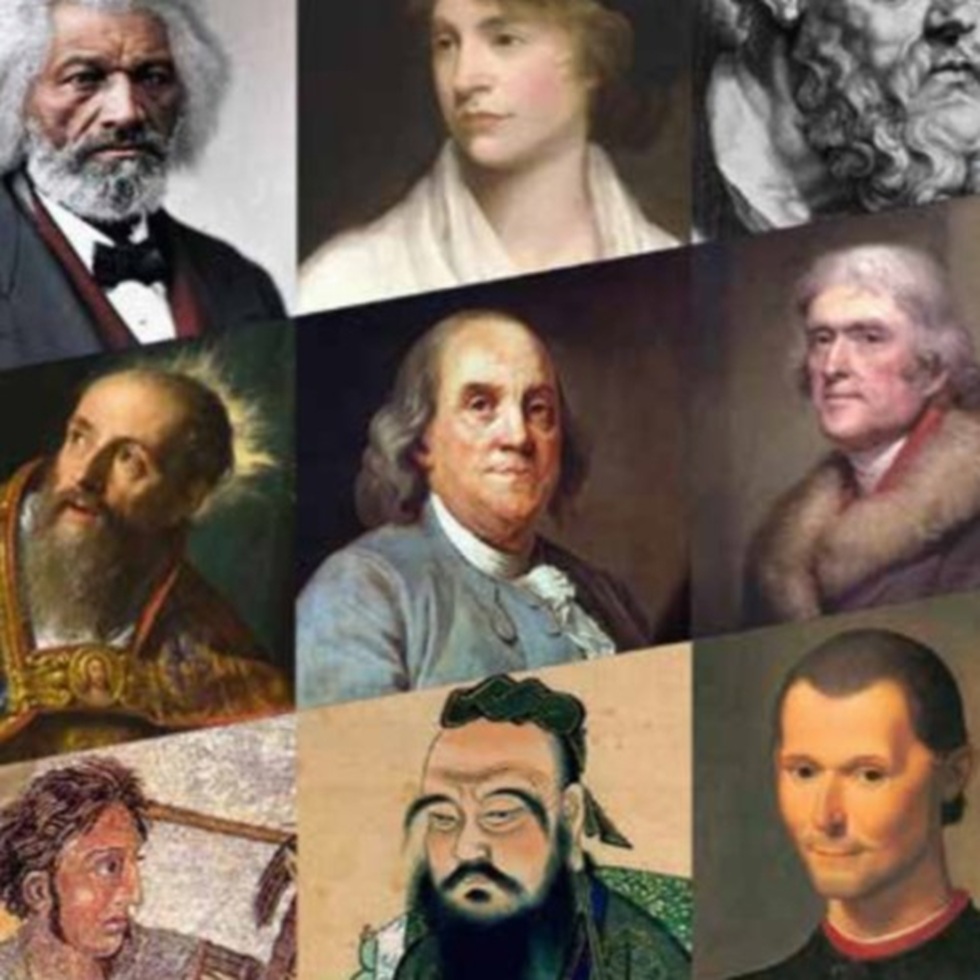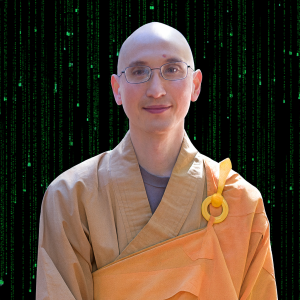
Are We Living in the Matrix? – A Buddhist Response
Below is an edited email exchange between an extension class participant and Bhikshu Jin Chuan, instructor and chaplain of DRBU.
Hello,
I was listening to your talk today, and what you spoke about finding a purpose in life is similar to what a person I know is going through. At a young age, this person questioned why he was alive and the purpose of being on this earth; however, lately his thoughts have become stronger and now has thoughts of:
Are we living in a Matrix, is this life even real??
What’s the point of being here? He sometimes even thinks, “I don’t want to be here anymore” (suicidal thoughts), but not to a point that he will do anything.
He doesn’t have depression, and he is not unhappy with his life, but for some reason these thoughts are coming up. Do you have any advice?
Respectfully,
Concerned Friend
Hello,
Sorry for the late response. Things have been quite busy here because we were preparing for the online Vesak. I started writing an email response, but it ended up as an essay. I hope it is helpful.
First, I resonate with what your friend is thinking. I had similar thoughts when I started questioning some of the assumptions of society, parents, friends, and so forth. It all seemed “constructed” and “imaginary.” The things people seemed to be chasing after seemed empty. What’s success? Making a lot of money? Looking cool among my friends? Getting a good job? Finding true love?
It’s like we are living in a fantasy world, a massively multiplayer online role-playing game, or simply “The Matrix.”
When I set out on the spiritual path, I wanted to find something REAL, not just a constructed illusion. And that is what began my quest into spirituality, religions, and meditation. I thought that there might be some answers there. In the end, I feel very fortunate that I have found some meaningful answers for myself.
Since you are asking for a Buddhist response, I’ll frame my answers in this context, but in the end, this search is a very personal one:
Each person needs to discover the answers for themselves.
The Dharma is not a dogmatic system that we simply believe in; it’s something to be investigated and experienced directly, known for ourselves. Ultimately, even the “Dharma” is simply part of the Matrix. It is not “real” in the ultimate sense.
The Vajra Sutra (also known as Diamond Sutra) says:
Subhuti, do not say the Tathagata thinks, ‘I have taught the Dharma.’ Do not have this thought. And why? If people say that the Tathagata has taught the Dharma, then he slanders the Buddha due to his inability to understand what I teach. Subhuti, with regards to the Dharma taught, there is actually no Dharma taught. This is called teaching the Dharma.
If we try to unpack this quote with the Matrix as a metaphor, the Buddha’s teachings, the Dharma, is not true reality because the teachings are still trapped in the symbols of the Matrix. However, these teachings are useful programs that lead us out of the Matrix.
If we attach to the Dharma as ultimately real, then we get stuck in another Matrix. We miss the main point of the Dharma: liberation.
In other words, the Buddha’s teachings are provisional hacks into the Matrix that allow us to get free. Meditation practice is choosing clarity and awareness over ignorance and ingrained habits.
Waking up in Buddhism is not a one time thing, but a constant practice of mindfulness.
We need to be aware all the time; otherwise, we simply fall into our pre-programmed routines. We end up mindlessly feeding the intelligent machines that control the Matrix.
With the rise of modern technology, marketing, and social media, we have become even more enmeshed in a virtual reality that is usually designed for someone else’s profit. If you want to look into this, I recommend watching a documentary series called Century of the Self. It starts with explaining how Edward Bernays (who is considered the father of public relations) constructed the “modern consumer” [link to movie on “engineering of consent” and creating “happiness machines”, breaking the stigma of women smoking]. He manipulates people’s subconscious desires. We think we are free to choose what we want, but we don’t realize that he has manufactured the actual desires that we are trying to satisfy. We only have the illusion of freedom. Welcome to the Matrix.
So, yes, we are trapped in the Matrix. There are intelligent machines (e.g. powerful people) that are using our energy and productivity for their own ends. Yet these “intelligent machines” or powerful people who manipulate the symbols of modern society, from the Buddhist perspective, are also trapped in their own Matrix. Most of them are not free either. (The ones that are truly free have no attachment to their power, status, wealth.) They suffer along with everyone else. They are often competing with their peers and scared to lose their advantage over others.
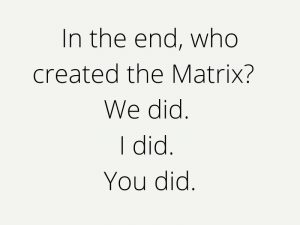 In the end, who created the Matrix? We did. I did. You did. We each create our own Matrix through our intentional actions of body, mouth, and mind. Every choice we make forms the “virtual reality” we live in (What is the true origin of the Matrix in the movie? The human mind. Humans created the intelligent machines that then created the Matrix.). Seen from this perspective, we then have the potential to mold our reality, but this requires us to take responsibility for our current existence. And this can be scary. Many people choose to continue to live in the Matrix. It is often more comforting to blame someone else for my current state: parents, society, culture, technology. Yes, there is some truth there, but if we stay in that narrative, we stay trapped. We are victims. We can only be free if someone else (or the entire world) changes.
In the end, who created the Matrix? We did. I did. You did. We each create our own Matrix through our intentional actions of body, mouth, and mind. Every choice we make forms the “virtual reality” we live in (What is the true origin of the Matrix in the movie? The human mind. Humans created the intelligent machines that then created the Matrix.). Seen from this perspective, we then have the potential to mold our reality, but this requires us to take responsibility for our current existence. And this can be scary. Many people choose to continue to live in the Matrix. It is often more comforting to blame someone else for my current state: parents, society, culture, technology. Yes, there is some truth there, but if we stay in that narrative, we stay trapped. We are victims. We can only be free if someone else (or the entire world) changes.
How do we get free of the Matrix? For the Buddha, he did not take the blue pill or the red pill, both are external. Instead, he took no pill. After recognizing human suffering–old age, sickness, and death, he went on a spiritual quest to find an answer. The solution he found was to go inward, to carefully observe his own mind and the nature of existence: how thoughts come and go, how causation works, and how ignorance is at the root of all suffering.
The Buddha poignantly says in the Dhammapada:
More than those who hate you,
more than all your enemies,
an undisciplined mind does greater harm.
More than your mother, more than your father,
more than all your family,
a well-disciplined mind does greater good.
(verses 42 & 43, Easwaran translation)
Rather than externalizing our problems as “out there,” the Buddha points to the real source of pain and suffering coming from ourselves, an undisciplined, untrained mind. He outlines a three-fold system of training: (1) a lifestyle conducive to freedom of mind (shila, virtue or precepts), (2) a practice of stabilizing the mind (i.e. samadhi, focus), and (3) a clarity free of prejudices and delusions (prajna, wisdom).
Real freedom does not come from taking a pill, but inner transformation.
The current mindfulness movement is heavily influenced by the Buddha’s insights. To get free, we have to be aware of what we are doing. To be aware of what we are doing, we need to live a life that is conducive to open space in the mind (not a lot of emotional storms or regrets). From this awareness comes insight into letting go of our attachments and seeing through our delusions. These insights then inform our lifestyle and vice versa. This is a virtuous cycle.
Opposed to the toxic cycle of mindlessness that brings us a life of affliction, worry, and regret. From the Buddha’s wisdom, “ignorance is not bliss.” Ignorance might bring some happiness in the short-term, but since it is not in accord with reality, there will be friction at some point, and that friction is where we suffer.
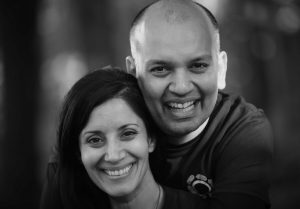
There are other “spiritual heroes” who have walked this path. When faced with adversity, they did not react with pre-programmed routines of hatred and revenge. They walked a path of peace and goodness. People in the past like Gandhi and the Peace Pilgrim, or people now like Nipun and Guri Mehta. Nipun and Guri’s interfaith marriage vows are not raging against the machine, but based on unconditional service, wisdom, and kindness.
And what does freedom look like? In Buddhism, life free of the Matrix is not waking up to a devastated wasteland where we fight for our basic survival.
Instead, we find an inner sense of well-being, generosity, and kindness.
We look at the world around us with a sense of gratitude, humility, and awe: a beautiful sunset, a star-filled sky (Seeing the beauty of nature requires us to stop looking at our electronic devices and literally “unplug.”). The Buddha realized nirvana, freedom from all suffering and delusion.
Still the spiritual path is often bittersweet. We have to face our shadows, question our identity, and challenge deeply ingrained habits. It might feel like a spiritual desert at times, but as we stop clinging so tightly to our opinions and habits, we find that there is relief, like a bird freed from his or her cage. We feel at home in our solitude. We no longer need to run after endless distractions, afraid that we are “missing out.” From this inner stability, we discover that we are deeply interconnected with others. Our very existence comes from the support of countless other people, other living beings, in fact, the entire universe (Is there really such a thing as an independent, self-contained individual?).
In the Avatamsaka Sutra, the Buddha describes the inconceivable potential of the mind. An analogy given for this Sutra is Indra’s Net, a celestial net that has a radiant pearl at each of its interstices. Each pearl reflects every other pearl, and in turn, each pearl contains a reflection of itself from all other pearls. These reflections go on infinitely, endlessly, like two mirrors reflecting each other. The Avatamsaka Sutra is literally “mind-blowing.” It opens us to what is possible when we let go of our assumptions around time and space, self and other, and even language and symbols itself. It’s a glimpse of what is possible outside of the Matrix that we have constructed for ourselves.
How do we relate to the Matrix?
Rather than all out war and violence, we choose peace and kindness.
Although Neo wakes up from the Matrix, he is in fact trapped in another Matrix. He plays by the same rules: he fights, he kills, he looks cool, he gets the girl. Sad to say, he is only planting the seeds for the Matrix to continue.
The movie does not present a real way out of the Matrix. You fight it endlessly through more guns, more violence, more power struggles, and ultimately, more adrenaline-action-packed scenes. This makes sense as The Matrix is a blockbuster movie designed to turn a profit for those who produce it. We need to be careful not to get trapped in its fantasy world as well (Sad to say, there are copycat killers.).
The Buddhist way out of delusion has no killing involved, only wisdom and compassion. There are no guns, only insight and mindfulness. There are no power plays, only letting go.
Real freedom is not in getting what we want, but being free of wants altogether.
It is not always being in control, but being free of the need to be in control. Keanu Reeves plays the Buddha upon awakening in the movie Little Buddha. When attacked by demons, he simply meditates (although Keanu looks a bit tense as he meditates). The fiery arrows turn into flowers. The Buddha does not fight back. He does not need to. His power comes from his inner virtue and freedom of mind. Demons both external and internal are subdued in his presence.
At the most profound level of wisdom, we no longer need to live a meaningful life.
We are free of the need for meaning altogether (Any structure of meaning is still within some “Matrix.” Note that this is not nihilism. “No meaning” is another label we use to interpret our experience.). From the Buddha’s vision, being completely free in this way is not selfish or passive, but selfless and engaged. Awakening to our interdependence activates an inner reservoir of care for all living beings, the entire world. By not being trapped in our Matrix, we can enter each living being’s Matrix skillfully. We can unconditionally support them in their process of waking up. No strings attached.
To answer the initial questions:
Are we living in a Matrix, is this life even real??
Yes and no. Our life is as real to the degree we can see through and let go of our fantasies and delusions.
What’s the point of being here?
Your choice, but be aware that the interpretation of “no point being here” is still a choice. For starters, we can choose not to delude or harm ourselves or others. We choose wisdom, clarity, and kindness. This is a significant choice. If we choose non-violence, then suicide is not an option.
In a Buddhist movie version of The Matrix, we would all begin in a Matrix of our own making. We are then given the choice of taking the red or blue pill every moment of our lives (even if we are unaware of it). We sometimes take the red; other times we take the blue. But when we discover that we do not have to take anything, our spiritual journey truly begins. Actually, we do not need to create another Buddhist movie. We are in one already. The question is, who writes the script?
Sincerely,
Jin Chuan
Subscribe to Our Newsletter
Get nourishing and mind-expanding writings in your inbox.
